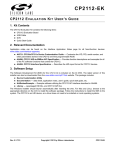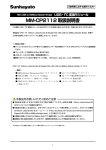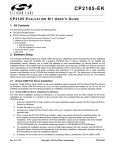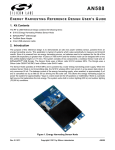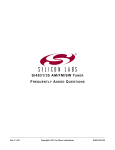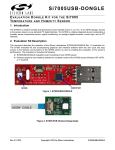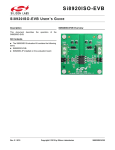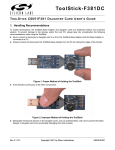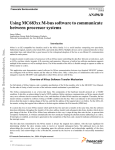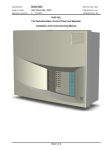Download Silicon Laboratories CP2112-EK User`s guide
Transcript
C P 2 11 2 - E K CP211 2 E VALUATION K I T U SER ’ S G UIDE 1. Kit Contents The CP2112 Evaluation Kit contains the following items: CP2112 Evaluation Board CP2112 Product Information CD-ROM. CD contents include: Example Windows and Mac Applications Documentation: CP2112 Data Sheet Evaluation Kit User's Guide AN495: CP2112 Interface Specification AN496: CP2112 HID USB-to-SMBus API Specification CP2112 USB Cable 2. Software Setup The included CD-ROM contains the example applications for PC® and Mac® and additional documentation. Insert the CD-ROM into a system’s CD-ROM drive. If using a Windows PC, an installer will automatically launch, allowing you to install the software or read documentation by clicking buttons on the Installation Panel. If the installer does not automatically start when you insert the CD-ROM, run autorun.exe found in the root directory of the CD-ROM. Refer to the ReleaseNotes CP211x CD.txt file on the CD-ROM for the latest information regarding versions and known problems and restrictions. If a non-Windows PC is used, manually browse to the directory on the CD-ROM that contains drivers for your OS. The instructions in this document assume that a Windows PC is being used. 3. CP2112 Hardware Interface Connect the CP2112 evaluation board to a PC as shown in Figure 1. 1. Connect one end of the USB cable to a USB Port on the PC. 2. Connect the other end of the USB cable to the USB connector on the CP2112 evaluation board. 3. Connect the SDA, SCL, and Ground pins on the CP2112 to an SMBus device. External pull-up resistors are not needed if the pull-up resistors on the CP2112 evaluation board are used. C P2112 Eval B oard PC U SB U SB C able C P2112 SD A SC L SD A SC L GND GND SM Bus D evice U SB Port Figure 1. Hardware Setup Rev. 0.2 9/10 Copyright © 2010 by Silicon Laboratories CP2112-EK CP2112-EK 4. CP2112 Windows Application The HIDSMBus Example application uses the Windows CP2112 HID-to-SMBus DLL to transmit and receive data with the CP2112. The application also has access to the CP2112’s GPIO pins. The HIDSMBus Example application is installed as part of the CD installation process. Figure 2 shows a screenshot of the Windows Application. The following steps describe how to start the application and use some of its features. 1. Ensure that the hardware is connected to a Windows PC as shown in Figure 1. If the device is properly connected, the red SUSPEND LED on the CP2112 evaluation board will turn on. 2. Launch the HidSmbus Example application, which is found by clicking StartAll ProgramsSilicon LaboratoriesCP2112 Evaluation KitHidSmbus Example. 3. In this application, you can configure the SMBus settings and GPIO pins, customize the device descriptors, and read/write data over the SMBus interface. 4. Select the appropriate device in the “Connection” drop down box and click Connect. After connecting to the device, you can configure the CP2112. 5. Figure 2 shows the Configuration tab, which allows you to get and set the SMBus configuration parameters. To set a parameter, modify the value that is in the corresponding text box or check/uncheck a box and click “Set SMBus Config”. To verify that the settings took place, click “Get SMBus Config”. These configuration parameters reset to their default values when the CP2112 is reset. Figure 2. Configuration Tab 2 Rev. 0.2 CP2112-EK 6. Figure 3 shows the Data Transfer tab, which allows you to transfer read and write data over the SMBus. 7. To Read data from an SMBus device (non-addressed mode): a. Enter the slave address in the “Read Request” box and the number of bytes to read. After this, click “Read Request” (shown in red). b. To see the number of bytes that were read back, click “Get Read/Write Transfer Status”, and verify the number of bytes read at the bottom of the application (show in blue). c. Next, click “Force Read Response” and then “Get Read Response” until you have read back the total number of bytes. The bytes will be shown in the “Received Data” field. The status of the CP2112 will be shown a the bottom of the PC app (shown in blue). 8. To read data from an EEPROM or similar device (addressed mode): a. Enter the slave address in the “Addressed Read Request” box, the number of address bytes in the target address, the target address of the SMBus device being read (in hex), and the number of bytes to read. After this, click “Address Read Request” (shown in green). b. To see the number of bytes that were read back, click Get Read/Write Transfer Status and verify the number of bytes read at the bottom of the application (show in blue). c. Next, click “Force Read Response” and then “Get Read Response” until you have read back the total number of bytes. The bytes will be shown in the “Received Data” field. The status of the CP2112 will be shown a the bottom of the PC app (shown in blue). 9. To write data over the SMBus interface: a. Enter the Slave address in the “Write Request” box and data (in hex) in the “Data to Write” box. After this, click “Write Request” (shown in purple). b. Next, click Get Read/Write Transfer Status, and verify that the transfer was complete at the bottom of the application (shown in blue). Figure 3. Data Transfer Tab Rev. 0.2 3 CP2112-EK 10. Figure 4 shows the Pin Configuration tab, which allows you to configure the GPIO and Special Functions (TX Toggle, RX Toggle, and Clock Output). a. GPIO pins toggle between Input/Ouput and Open-Drain/Push-Pull by clicking the corresponding GPIO boxes in the “GPIO Configuration” section. The boxes for TX Toggle, RX Toggle, and Clock Output can be checked to enable the Special Functionality. The “Set GPIO Config” button must be clicked in order for the settings to change. b. The “Latch Values” section allows for the GPIO latches to be read or written to. Clicking the box next the GPIO pins listed will scroll through “1”, “0”, and “X”. Write Latch must be clicked to change the state of the GPIO latch. Figure 4. Pin Configuration Tab 4 Rev. 0.2 CP2112-EK 11. Figure 5 shows the Customization tab, which allows you to program the One-Time-Programmable (OTP) parameters of the device. The parameters that are programmed with this tab can only be programmed once and cannot be changed back to their default values after being programmed. This tab has the same functionality as the CP2112SetIDs application in the software in “AN144: CP210x/CP211x Device Customization Guide”. In order for these parameters to be sucessfully programmed, there must be a 4.7 µF capacitor connected between the VPP pin and ground. The CP2112-EK board has this capacitor. See "6. Schematic" on page 8 for more details on the evaulation board schematic. a. The “USB Customization” section allows you to program USB parameters. To get the current settings, click “Get”. To modify the parameters, change the settings by modifying the text boxes and checking the box next to the parameter being modified. After this, click “Set”. Without checking the corresponding box, the parameter will not be changed. Perform a “Get” after changing any parameters to ensure that the settings were changed. b. The “String Descriptors” section allows you to program the serial strings of the CP2112. To modify these, type a string into the corresponding text box and click “Set”. Perform a “Get” after changing any parameters to ensure that the settings were changed. c. The “Lock Byte” section shows which fields have been programmed and allows you to lock fields from being modified. Any field that has been programmed will not be checked. To prevent a field from being programmed, uncheck the corresponding box and then click “Set”. Perform a “Get” after changing any parameters to ensure that the settings were changed. Figure 5. Customization Tab Rev. 0.2 5 CP2112-EK 5. Target Board The CP2112 Evaluation Kit includes an evaluation board with a CP2112 device pre-installed for evaluation and preliminary software development. Numerous input/output (I/O) connections are provided to facilitate prototyping using the evaluation board. Refer to Figure 6 for the locations of the various I/O connectors. Refer to Figure 7, “CP2112 Evaluation Board Schematic” for information regarding the SMBus pull-up resistors that are located on the target board. P1 USB connector for USB interface H1 Access Connector for SMBus interface (SDA, SCL, GND, Pull-Up Voltage) J1, J2, J3, J4 GPIO access connectors J6 Power connector J7 SMBus pull-up voltage connector J8 Red SUSPEND LED connector DS0–DS7 Green GPIO LEDs DS8 Red SUSPEND LED TB1 SMBus interface terminal block J4 J3 GND EXT_PU CP2112 J2 DS3 DS2 EXT_PU J1 CP2112-EK www.silabs.com DS1 DS0 J7 SMBUS PU_V VIO VDD +3V NET A SDA SCL P1 DS8 U1 DS5 DS4 H1 EXT_PU GND SUSPEND VIO SILICON LABS TB1 J8 DS7 DS6 J6 Figure 6. CP2112 Evaluation Board with Default Shorting Blocks Installed 5.1. LED Headers (J1, J2, J3, J4) Connectors J1, J2, J3, and J4 are provided to allow access to the GPIO pins on the CP2112. Place shorting blocks on J1, J2, J3, and J4 to connect the GPIO pins to the eight green LEDs, DS0–DS7. These LEDs can be used to indicate active communications through the CP2112. Table 1 lists the LED corresponding to each header position. Table 1. J2 and J3 LED Locations 6 LED Pins DS0 J1[3:4] DS1 J1[1:2] DS2 J2[3:4] DS3 J2[1:2] DS4 J3[3:4] DS5 J3[1:2] DS6 J4[3:4] DS7 J4[1:2] Rev. 0.2 CP2112-EK 5.2. Universal Serial Bus (USB) Interface (P1) A Universal Serial Bus (USB) connector (P1) is provided to facilitate connections to the USB interface on the CP2112. See Table 2 for the USB pin definitions. Table 2. USB Connector Pin Descriptions Pin # Description 1 VBUS 2 D- 3 D+ 4 GND (Ground) 5.3. SMBus Signals (TB1, H1) The SMBus interface terminal block and access headers are included to easily interace SMBus devices to the evaluation board. The terminal block can be used to connect wires to the board, and the access connectors can be used to connect scope probes to the SMBus interface for debugging. The signals that are accessible through these two connectors are SDA, SCL, GND, and the external pull-up voltage signal. 5.4. VDD and VIO Power Connector (J6) This header (J6) is included on the evaluation board to provide several power options. The following describes the function of each pin: Pins 1–2: Connect CP2112 VIO input (pin 5) to CP2112 VDD (Pin 6). Remove the shorting block to power VIO from an external source. Pins 3–4: Connects the main +3 V net to the CP2112 VDD (Pin 6). The main +3 V net powers the other components (eight green LEDs) on the board. 5.5. SMBus Pull-Up Voltage Connector (J7) This header (J7) is included on the evaluation board to provide power options for SMBus pull-up voltage. The following describes the function of each pin: J7[1:2]: Connects CP2112 VIO pin (Pin 5) to the 4.7 k pull-up resistors located on the evaluation board. J7[2:3]: Connects the External Pull-Up signal from TB1 (Pin 4) to the 4.7 kpull-up resistors on the evaluation board. 5.6. SUSPEND LED Connector (J8) The J8 header is used to connect the CP2112 SUSPEND pin (Pin 17) to the DS8 red LED. When the LED is on, the device has enumerated with the PC operating normally. When the LED is off, the device has not yet enumerated or is in the USB Suspend state. Rev. 0.2 7 Figure 7. CP2112 Evaluation Board Schematic CP2112-EK 6. Schematic 8 Rev. 0.2 CP2112-EK DOCUMENT CHANGE LIST Revision 0.1 to Revision 0.2 Updated Figure 1. Updated "4. CP2112 Windows Application" on page 2. Instructions and figures from updated PC application Updated Figure 7 on page 8. Rev. 0.2 9 CP2112-EK CONTACT INFORMATION Silicon Laboratories Inc. 400 West Cesar Chavez Austin, TX 78701 Tel: 1+(512) 416-8500 Fax: 1+(512) 416-9669 Toll Free: 1+(877) 444-3032 Please visit the Silicon Labs Technical Support web page: https://www.silabs.com/support/pages/contacttechnicalsupport.aspx and register to submit a technical support request. The information in this document is believed to be accurate in all respects at the time of publication but is subject to change without notice. Silicon Laboratories assumes no responsibility for errors and omissions, and disclaims responsibility for any consequences resulting from the use of information included herein. Additionally, Silicon Laboratories assumes no responsibility for the functioning of undescribed features or parameters. Silicon Laboratories reserves the right to make changes without further notice. Silicon Laboratories makes no warranty, representation or guarantee regarding the suitability of its products for any particular purpose, nor does Silicon Laboratories assume any liability arising out of the application or use of any product or circuit, and specifically disclaims any and all liability, including without limitation consequential or incidental damages. Silicon Laboratories products are not designed, intended, or authorized for use in applications intended to support or sustain life, or for any other application in which the failure of the Silicon Laboratories product could create a situation where personal injury or death may occur. Should Buyer purchase or use Silicon Laboratories products for any such unintended or unauthorized application, Buyer shall indemnify and hold Silicon Laboratories harmless against all claims and damages. Silicon Laboratories, Silicon Labs, and USBXpress are trademarks of Silicon Laboratories Inc. Other products or brandnames mentioned herein are trademarks or registered trademarks of their respective holders. 10 Rev. 0.2










